Danish vs Scandinavian Community Comparison
COMPARE
Danish
Scandinavian
Social Comparison
Social Comparison
Danes
Scandinavians
8,781
SOCIAL INDEX
85.3/ 100
SOCIAL RATING
48th/ 347
SOCIAL RANK
7,944
SOCIAL INDEX
76.9/ 100
SOCIAL RATING
98th/ 347
SOCIAL RANK
Scandinavian Integration in Danish Communities
The statistical analysis conducted on geographies consisting of 425,547,439 people shows a substantial positive correlation between the proportion of Scandinavians within Danish communities in the United States with a correlation coefficient (R) of 0.540. On average, for every 1% (one percent) increase in Danes within a typical geography, there is an increase of 0.091% in Scandinavians. To illustrate, in a geography comprising of 100,000 individuals, a rise of 1,000 Danes corresponds to an increase of 91.1 Scandinavians.
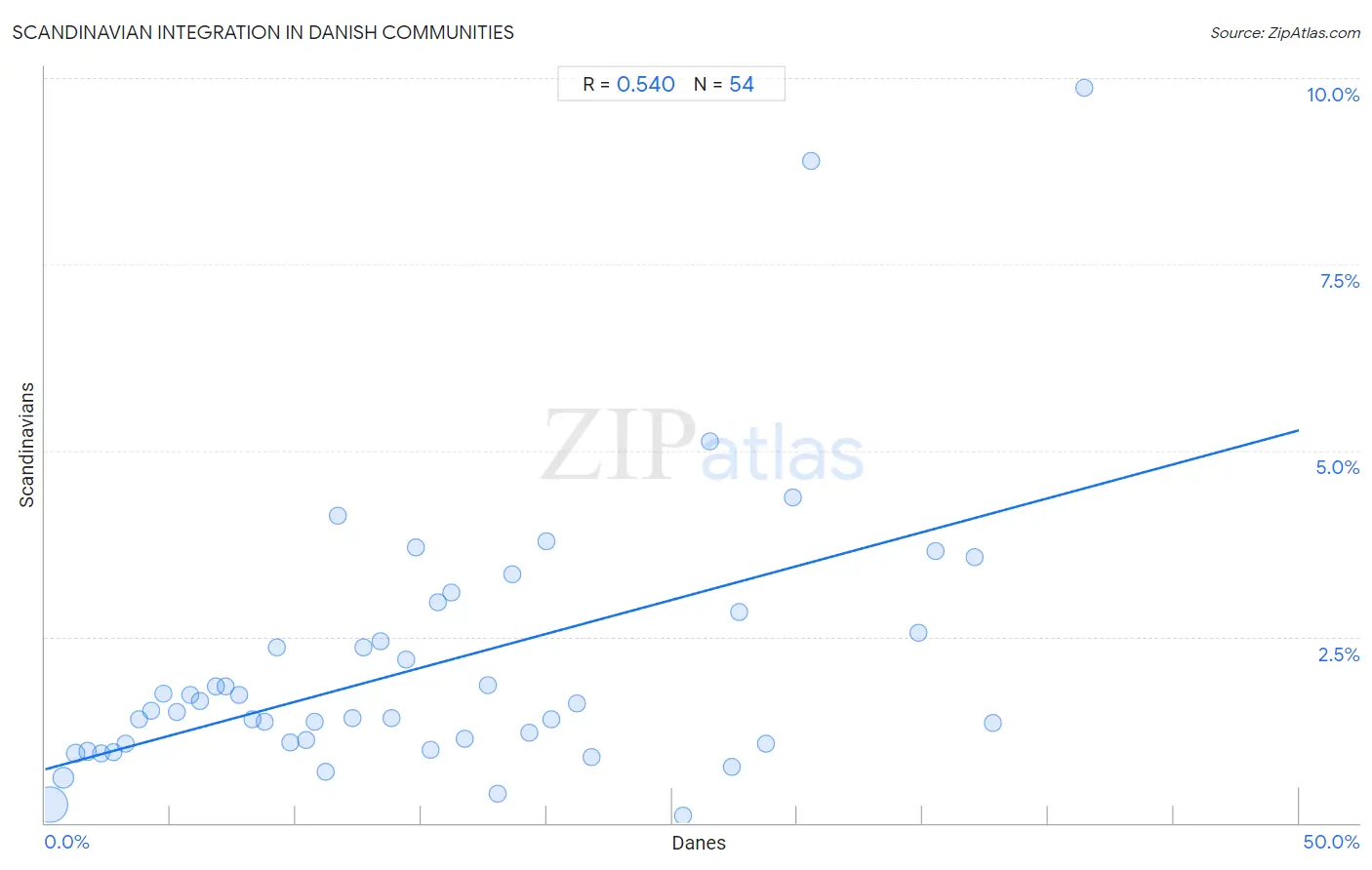
Danish vs Scandinavian Income
When considering income, the most significant differences between Danish and Scandinavian communities in the United States are seen in wage/income gap (31.0% compared to 29.1%, a difference of 6.4%), householder income ages 45 - 64 years ($105,619 compared to $102,969, a difference of 2.6%), and householder income over 65 years ($63,117 compared to $61,586, a difference of 2.5%). Conversely, both communities are more comparable in terms of median earnings ($46,392 compared to $46,433, a difference of 0.090%), per capita income ($44,095 compared to $43,848, a difference of 0.56%), and householder income under 25 years ($53,041 compared to $52,654, a difference of 0.73%).

| Income Metric | Danish | Scandinavian |
| Per Capita Income | Good $44,095 | Average $43,848 |
| Median Family Income | Excellent $105,900 | Good $104,410 |
| Median Household Income | Excellent $87,676 | Good $86,073 |
| Median Earnings | Average $46,392 | Average $46,433 |
| Median Male Earnings | Excellent $56,246 | Good $55,527 |
| Median Female Earnings | Tragic $37,730 | Tragic $38,306 |
| Householder Age | Under 25 years | Excellent $53,041 | Good $52,654 |
| Householder Age | 25 - 44 years | Excellent $97,221 | Good $95,596 |
| Householder Age | 45 - 64 years | Exceptional $105,619 | Good $102,969 |
| Householder Age | Over 65 years | Exceptional $63,117 | Good $61,586 |
| Wage/Income Gap | Tragic 31.0% | Tragic 29.1% |
Danish vs Scandinavian Poverty
When considering poverty, the most significant differences between Danish and Scandinavian communities in the United States are seen in receiving food stamps (9.0% compared to 9.7%, a difference of 7.7%), child poverty among boys under 16 (13.6% compared to 14.4%, a difference of 5.7%), and child poverty under the age of 16 (13.4% compared to 14.1%, a difference of 5.4%). Conversely, both communities are more comparable in terms of married-couple family poverty (4.1% compared to 4.1%, a difference of 0.11%), single mother poverty (28.5% compared to 28.9%, a difference of 1.5%), and single female poverty (20.7% compared to 21.1%, a difference of 1.9%).
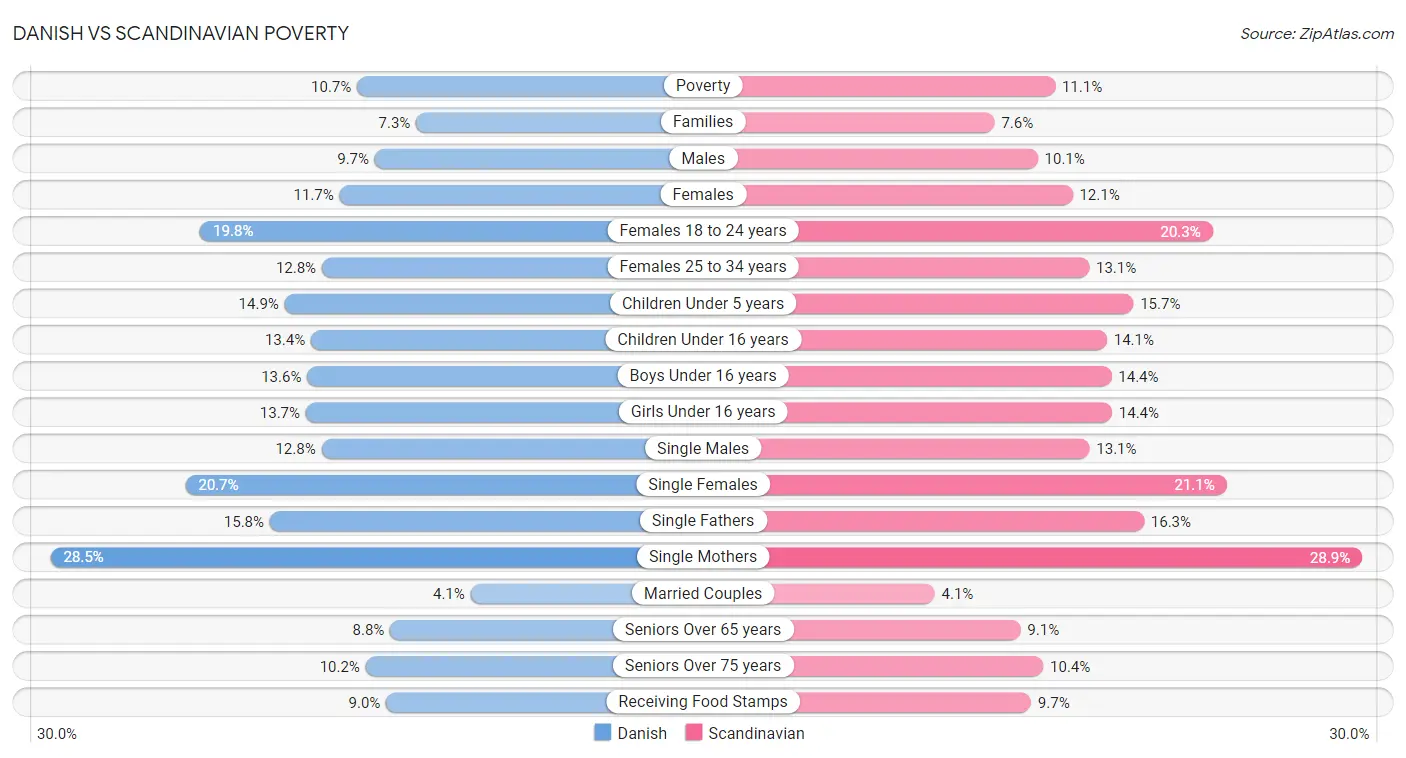
| Poverty Metric | Danish | Scandinavian |
| Poverty | Exceptional 10.7% | Exceptional 11.1% |
| Families | Exceptional 7.3% | Exceptional 7.6% |
| Males | Exceptional 9.7% | Exceptional 10.1% |
| Females | Exceptional 11.7% | Exceptional 12.1% |
| Females 18 to 24 years | Good 19.8% | Fair 20.3% |
| Females 25 to 34 years | Exceptional 12.8% | Excellent 13.1% |
| Children Under 5 years | Exceptional 14.9% | Exceptional 15.7% |
| Children Under 16 years | Exceptional 13.4% | Exceptional 14.1% |
| Boys Under 16 years | Exceptional 13.6% | Exceptional 14.4% |
| Girls Under 16 years | Exceptional 13.7% | Exceptional 14.4% |
| Single Males | Average 12.8% | Poor 13.1% |
| Single Females | Good 20.7% | Average 21.1% |
| Single Fathers | Exceptional 15.8% | Average 16.3% |
| Single Mothers | Excellent 28.5% | Good 28.9% |
| Married Couples | Exceptional 4.1% | Exceptional 4.1% |
| Seniors Over 65 years | Exceptional 8.8% | Exceptional 9.1% |
| Seniors Over 75 years | Exceptional 10.2% | Exceptional 10.4% |
| Receiving Food Stamps | Exceptional 9.0% | Exceptional 9.7% |
Danish vs Scandinavian Unemployment
When considering unemployment, the most significant differences between Danish and Scandinavian communities in the United States are seen in unemployment among women with children ages 6 to 17 years (8.1% compared to 8.6%, a difference of 5.2%), unemployment among women with children under 18 years (4.5% compared to 4.8%, a difference of 5.1%), and male unemployment (4.5% compared to 4.7%, a difference of 4.7%). Conversely, both communities are more comparable in terms of unemployment among seniors over 65 years (4.9% compared to 4.9%, a difference of 0.010%), unemployment among seniors over 75 years (9.7% compared to 9.7%, a difference of 0.67%), and unemployment among ages 65 to 74 years (5.2% compared to 5.2%, a difference of 0.79%).
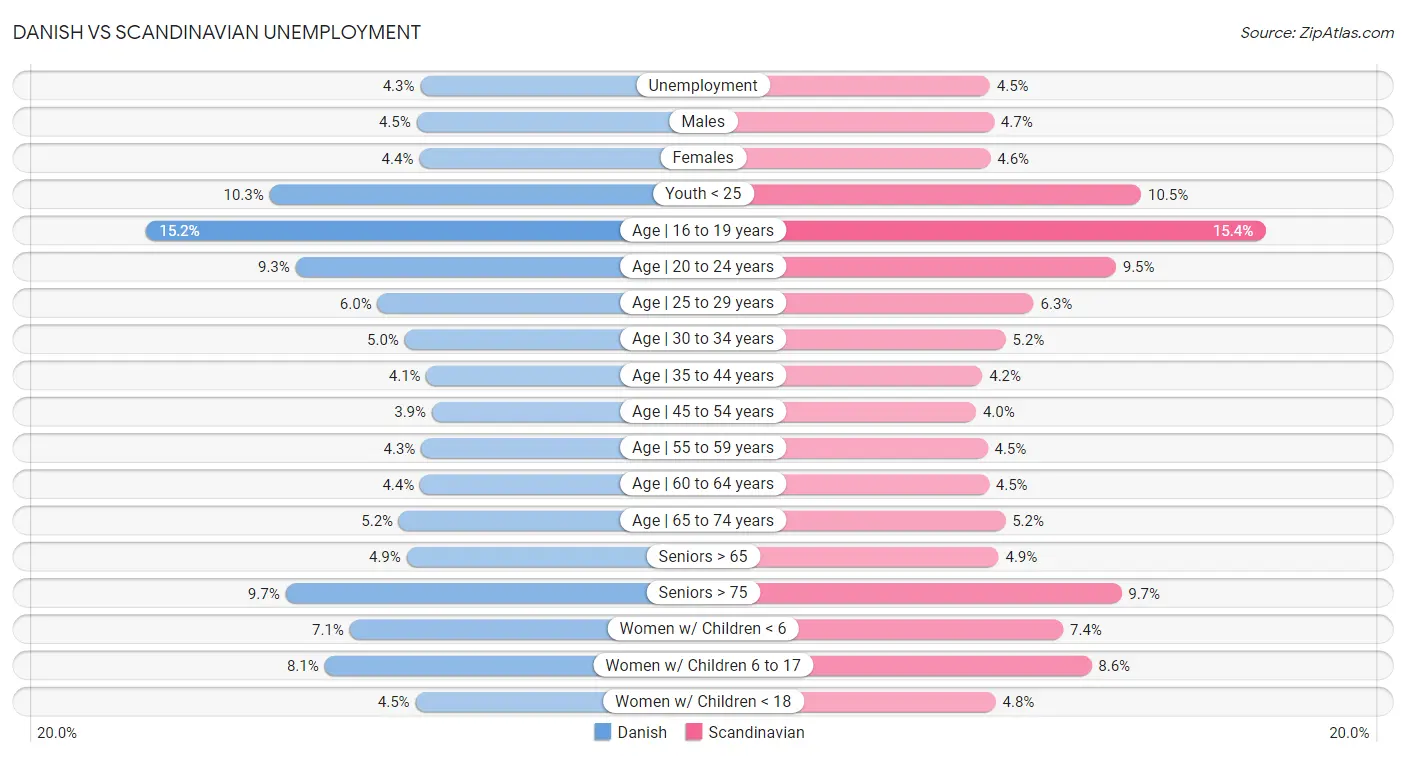
| Unemployment Metric | Danish | Scandinavian |
| Unemployment | Exceptional 4.3% | Exceptional 4.5% |
| Males | Exceptional 4.5% | Exceptional 4.7% |
| Females | Exceptional 4.4% | Exceptional 4.6% |
| Youth < 25 | Exceptional 10.3% | Exceptional 10.5% |
| Age | 16 to 19 years | Exceptional 15.2% | Exceptional 15.4% |
| Age | 20 to 24 years | Exceptional 9.3% | Exceptional 9.5% |
| Age | 25 to 29 years | Exceptional 6.0% | Exceptional 6.3% |
| Age | 30 to 34 years | Exceptional 5.0% | Exceptional 5.2% |
| Age | 35 to 44 years | Exceptional 4.1% | Exceptional 4.2% |
| Age | 45 to 54 years | Exceptional 3.9% | Exceptional 4.0% |
| Age | 55 to 59 years | Exceptional 4.3% | Exceptional 4.5% |
| Age | 60 to 64 years | Exceptional 4.4% | Exceptional 4.5% |
| Age | 65 to 74 years | Exceptional 5.2% | Exceptional 5.2% |
| Seniors > 65 | Exceptional 4.9% | Exceptional 4.9% |
| Seniors > 75 | Tragic 9.7% | Tragic 9.7% |
| Women w/ Children < 6 | Exceptional 7.1% | Excellent 7.4% |
| Women w/ Children 6 to 17 | Exceptional 8.1% | Exceptional 8.6% |
| Women w/ Children < 18 | Exceptional 4.5% | Exceptional 4.8% |
Danish vs Scandinavian Labor Participation
When considering labor participation, the most significant differences between Danish and Scandinavian communities in the United States are seen in in labor force | age 16-19 (44.7% compared to 43.6%, a difference of 2.5%), in labor force | age 20-24 (79.0% compared to 78.5%, a difference of 0.59%), and in labor force | age > 16 (65.3% compared to 65.0%, a difference of 0.41%). Conversely, both communities are more comparable in terms of in labor force | age 35-44 (84.3% compared to 84.4%, a difference of 0.080%), in labor force | age 25-29 (84.8% compared to 84.9%, a difference of 0.15%), and in labor force | age 20-64 (79.9% compared to 79.7%, a difference of 0.29%).

| Labor Participation Metric | Danish | Scandinavian |
| In Labor Force | Age > 16 | Good 65.3% | Fair 65.0% |
| In Labor Force | Age 20-64 | Exceptional 79.9% | Good 79.7% |
| In Labor Force | Age 16-19 | Exceptional 44.7% | Exceptional 43.6% |
| In Labor Force | Age 20-24 | Exceptional 79.0% | Exceptional 78.5% |
| In Labor Force | Age 25-29 | Good 84.8% | Excellent 84.9% |
| In Labor Force | Age 30-34 | Tragic 84.3% | Fair 84.5% |
| In Labor Force | Age 35-44 | Fair 84.3% | Average 84.4% |
| In Labor Force | Age 45-54 | Exceptional 83.3% | Good 83.0% |
Danish vs Scandinavian Family Structure
When considering family structure, the most significant differences between Danish and Scandinavian communities in the United States are seen in single mother households (5.5% compared to 5.8%, a difference of 4.0%), births to unmarried women (28.7% compared to 29.8%, a difference of 3.7%), and divorced or separated (11.9% compared to 12.3%, a difference of 3.4%). Conversely, both communities are more comparable in terms of average family size (3.17 compared to 3.14, a difference of 1.1%), family households (66.0% compared to 65.0%, a difference of 1.5%), and single father households (2.3% compared to 2.4%, a difference of 1.7%).

| Family Structure Metric | Danish | Scandinavian |
| Family Households | Exceptional 66.0% | Exceptional 65.0% |
| Family Households with Children | Exceptional 28.7% | Exceptional 28.0% |
| Married-couple Households | Exceptional 51.1% | Exceptional 49.6% |
| Average Family Size | Tragic 3.17 | Tragic 3.14 |
| Single Father Households | Average 2.3% | Fair 2.4% |
| Single Mother Households | Exceptional 5.5% | Exceptional 5.8% |
| Currently Married | Exceptional 50.5% | Exceptional 49.5% |
| Divorced or Separated | Excellent 11.9% | Poor 12.3% |
| Births to Unmarried Women | Exceptional 28.7% | Exceptional 29.8% |
Danish vs Scandinavian Vehicle Availability
When considering vehicle availability, the most significant differences between Danish and Scandinavian communities in the United States are seen in 4 or more vehicles in household (8.6% compared to 8.0%, a difference of 7.4%), no vehicles in household (6.6% compared to 7.0%, a difference of 6.5%), and 3 or more vehicles in household (24.7% compared to 23.6%, a difference of 4.7%). Conversely, both communities are more comparable in terms of 1 or more vehicles in household (93.5% compared to 93.1%, a difference of 0.46%), 2 or more vehicles in household (63.3% compared to 62.1%, a difference of 1.9%), and 3 or more vehicles in household (24.7% compared to 23.6%, a difference of 4.7%).

| Vehicle Availability Metric | Danish | Scandinavian |
| No Vehicles Available | Exceptional 6.6% | Exceptional 7.0% |
| 1+ Vehicles Available | Exceptional 93.5% | Exceptional 93.1% |
| 2+ Vehicles Available | Exceptional 63.3% | Exceptional 62.1% |
| 3+ Vehicles Available | Exceptional 24.7% | Exceptional 23.6% |
| 4+ Vehicles Available | Exceptional 8.6% | Exceptional 8.0% |
Danish vs Scandinavian Education Level
When considering education level, the most significant differences between Danish and Scandinavian communities in the United States are seen in doctorate degree (1.9% compared to 1.8%, a difference of 3.7%), professional degree (4.4% compared to 4.2%, a difference of 3.0%), and no schooling completed (1.5% compared to 1.5%, a difference of 2.5%). Conversely, both communities are more comparable in terms of 7th grade (97.4% compared to 97.4%, a difference of 0.030%), nursery school (98.6% compared to 98.6%, a difference of 0.040%), and kindergarten (98.6% compared to 98.6%, a difference of 0.040%).
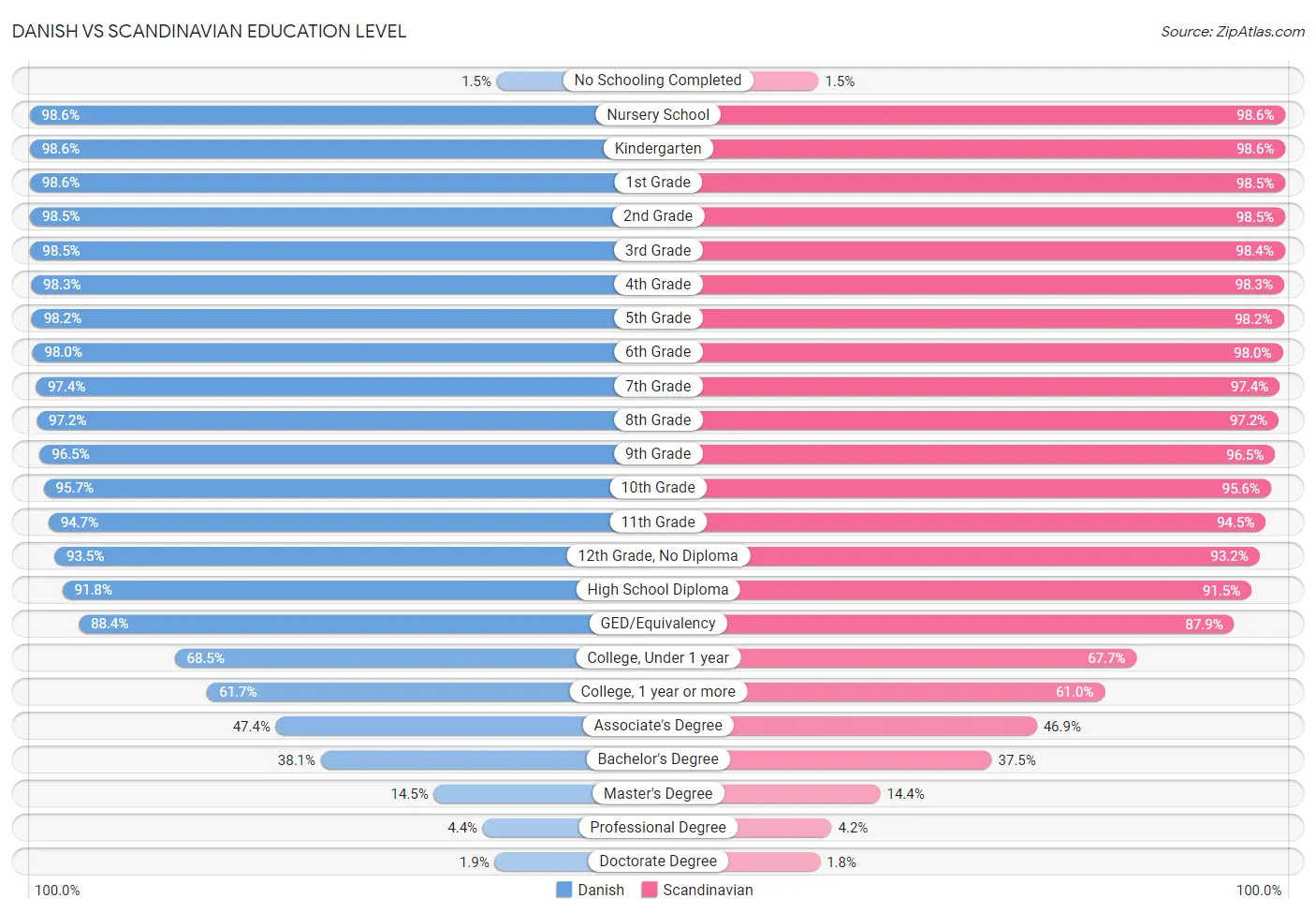
| Education Level Metric | Danish | Scandinavian |
| No Schooling Completed | Exceptional 1.5% | Exceptional 1.5% |
| Nursery School | Exceptional 98.6% | Exceptional 98.6% |
| Kindergarten | Exceptional 98.6% | Exceptional 98.6% |
| 1st Grade | Exceptional 98.6% | Exceptional 98.5% |
| 2nd Grade | Exceptional 98.5% | Exceptional 98.5% |
| 3rd Grade | Exceptional 98.5% | Exceptional 98.4% |
| 4th Grade | Exceptional 98.3% | Exceptional 98.3% |
| 5th Grade | Exceptional 98.2% | Exceptional 98.2% |
| 6th Grade | Exceptional 98.0% | Exceptional 98.0% |
| 7th Grade | Exceptional 97.4% | Exceptional 97.4% |
| 8th Grade | Exceptional 97.2% | Exceptional 97.2% |
| 9th Grade | Exceptional 96.5% | Exceptional 96.5% |
| 10th Grade | Exceptional 95.7% | Exceptional 95.6% |
| 11th Grade | Exceptional 94.7% | Exceptional 94.5% |
| 12th Grade, No Diploma | Exceptional 93.5% | Exceptional 93.2% |
| High School Diploma | Exceptional 91.8% | Exceptional 91.5% |
| GED/Equivalency | Exceptional 88.4% | Exceptional 87.9% |
| College, Under 1 year | Exceptional 68.5% | Exceptional 67.7% |
| College, 1 year or more | Exceptional 61.7% | Excellent 61.0% |
| Associate's Degree | Good 47.4% | Good 46.9% |
| Bachelor's Degree | Average 38.1% | Average 37.5% |
| Master's Degree | Fair 14.5% | Fair 14.4% |
| Professional Degree | Average 4.4% | Fair 4.2% |
| Doctorate Degree | Good 1.9% | Average 1.8% |
Danish vs Scandinavian Disability
When considering disability, the most significant differences between Danish and Scandinavian communities in the United States are seen in self-care disability (2.3% compared to 2.4%, a difference of 5.8%), ambulatory disability (5.8% compared to 6.1%, a difference of 4.9%), and vision disability (2.1% compared to 2.2%, a difference of 4.6%). Conversely, both communities are more comparable in terms of disability age over 75 (46.2% compared to 46.6%, a difference of 0.91%), cognitive disability (16.7% compared to 16.9%, a difference of 1.2%), and hearing disability (3.6% compared to 3.6%, a difference of 1.5%).
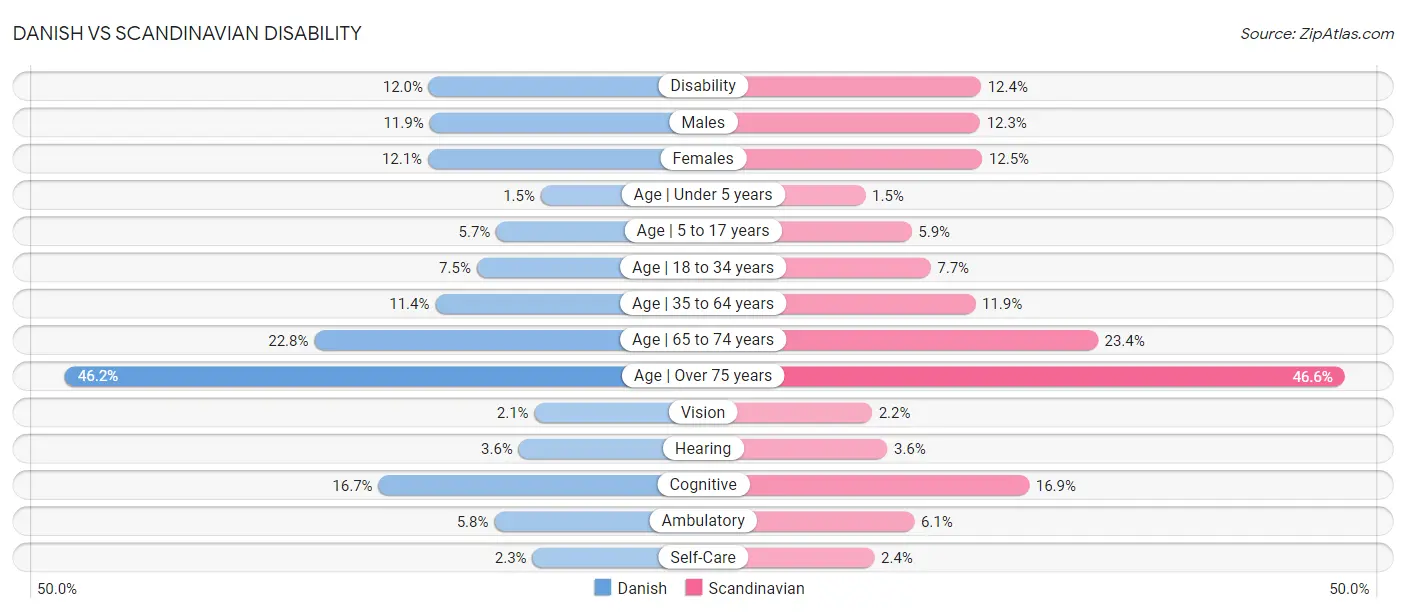
| Disability Metric | Danish | Scandinavian |
| Disability | Tragic 12.0% | Tragic 12.4% |
| Males | Tragic 11.9% | Tragic 12.3% |
| Females | Good 12.1% | Tragic 12.5% |
| Age | Under 5 years | Tragic 1.5% | Tragic 1.5% |
| Age | 5 to 17 years | Fair 5.7% | Tragic 5.9% |
| Age | 18 to 34 years | Tragic 7.5% | Tragic 7.7% |
| Age | 35 to 64 years | Fair 11.4% | Tragic 11.9% |
| Age | 65 to 74 years | Excellent 22.8% | Average 23.4% |
| Age | Over 75 years | Exceptional 46.2% | Exceptional 46.6% |
| Vision | Exceptional 2.1% | Average 2.2% |
| Hearing | Tragic 3.6% | Tragic 3.6% |
| Cognitive | Exceptional 16.7% | Exceptional 16.9% |
| Ambulatory | Exceptional 5.8% | Average 6.1% |
| Self-Care | Exceptional 2.3% | Exceptional 2.4% |